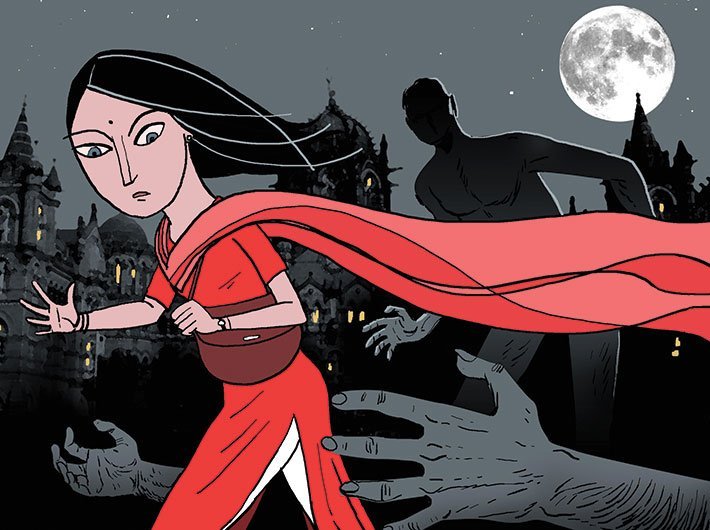A total of 338,954 incidents of crime against women were registered in 2016, an increase by 2.9 percent over 329,243 cases reported in 2015.
In the past two months, two girls have faced unspeakable violence. In January, a Dalit schoolgirl in Haryana was gang-raped and murdered. In Jharkand in February, a 15-year-old girl was raped and burnt alive. Horrifying stories like this put the spotlight on violence against women in India.
The impunity with which so many crimes are being committed against women not only highlights the failings of the justice system, but also indicates to lack of fear of retribution among perpetrators. Remember Mukesh Singh, one of the convicts in the Nirbhaya gang-rape case, who is facing the death penalty? He expressed no remorse in the BBC documentary ‘India’s Daughters’, instead blaming Nirbhaya’s death to her courage in fighting back. Though the film was banned in India for allegedly showing the country in poor light, it provided an insight into the sinister minds of rapists who don’t even consider their acts to be heinous offences.
This is arguably a major reason why violence against women and girls continues unabated and has become one of the most pressing problems in our country. Data released by the National Crime Records Bureau (NCRB) has reinforced this fact. A total of 338,954 incidents of crime against women were registered in 2016, an increase by 2.9 percent over 329,243 cases reported in 2015. These statistics do not include the thousands of cases that go unreported, again due to the daunting criminal justice system.
According to the NCRB data, the majority of cases (32.6 percent) reported as crimes against women were registered under ‘Cruelty by husband or his relatives’, followed by ‘assault on woman with intent to outrage her modesty’ (25 percent), kidnapping and abduction of women (19 percent) and rape (11.5 percent). There was also a 12 percent spike in the number of rape cases, from 34,651 cases in 2015 to 38,947 cases in 2016. Madhya Pradesh and Uttar Pradesh reported the highest incidents of rape, with 4,882 (12.5 percent) and 4,816 (12.4 percent) respectively.
The data revealed violence against women being common in major cities, with Delhi and Mumbai appearing to be the least safe for women. Delhi topped the list of 19 cities, being home to 33 percent of total crimes committed against women last year, followed by Mumbai with 12.3 percent. The national capital also accounted for the highest number of rape cases (40 percent), maintaining the dubious tag of being the most unsafe city for women.
But why do we see so much violence against women?
Gender-based violence is seen everywhere, and it varies in form and degree, cutting across divisions of class, religion, ethnicity, culture, geography and age. There is hardly any place in the world that can be said to be safe for women. The roots of this violence lie in persistent discrimination against women, and are a direct manifestation of patriarchal mindsets - in the streets, in homes and in workplaces.
According to the UN secretary-general’s in-depth study on all forms of violence against women, it “cannot be attributed solely to individual psychological factors or socio economic conditions” and explanations for violence should therefore look into the “broader impact of systemic gender inequality and women’s subordination… within the larger social context of power relations”.
Violence against women actually starts before they are born. The preference for a son over a daughter, which is frighteningly pervasive in our society, makes girl embryos victims of sex-selective abortion. During her childhood, she faces all sorts of discrimination, starting from access to food and extending to healthcare and education. Discrimination and denial of rights not only engender violence against women, but are also crimes in themselves.
Adolescence is often the most dangerous phase, in which many girls are subjected to harassment, stalking, trafficking, and sexual abuse, among others. Violence against women and girls continues in many forms throughout their adult life, with the emergence of honour killings, domestic and dowry related violence, and marital rape.
According to a 2016 study by ActionAid UK, more than four in 10 women (41 percent) in India said they had experienced harassment or violence before the age of 19. The research also found that around three quarters (73 percent) of women in India had experienced some form of violence or harassment in the month prior to when the study was conducted. The figure was even higher in other countries, with 67 percent of women polled in Thailand, 87 percent in Brazil and 57 percent in the UK saying they were subjected to harassment or violence in that period.
Women are rarely safe. The time has come for us as a society to reflect upon ourselves. We must recognize the pervasive misogyny and toxic masculinity in our homes, our cities and our country for what it is. It is time to respect women and stand in solidarity with those who have survived violence and are fighting for justice.
The 15-year-old girl in Jharkhand, who was raped, made her brave contribution to the struggle in her final moments: while her attackers attempted to silence her with flames, she resisted, making her way home to share the culprits’ names before she died. The millions of women who face violence in their lifetime show incredible strength through myriad forms of resistance. It is our duty as a society to act with them.
(Pattnaik works with ActionAid India)
